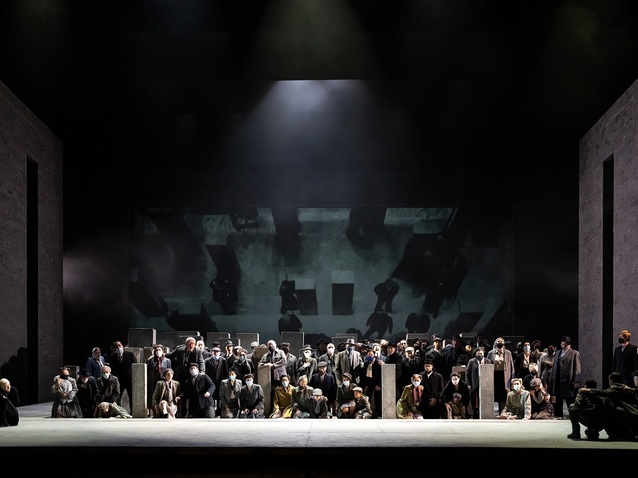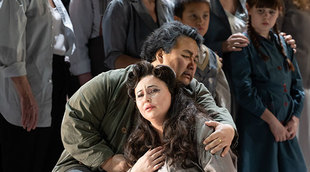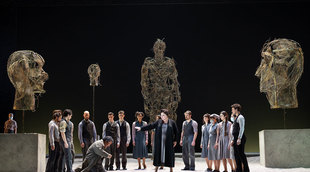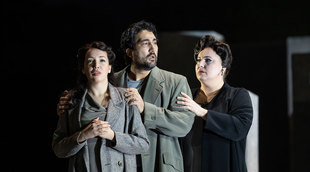 © Bill Cooper
© Bill Cooper
Written in 1841, Nabucco is considered to be the opera that established Giuseppe Verdi’s reputation as a composer. The Italian libretto by Temistocle Solera is based on the biblical books of 2 Kings, Jeremiah, Lamentations and Daniel and the 1836 play by Auguste Anicet-Bourgeois and Francis Come, although Antonio Cortese’s 1836 ballet adaptation of the latter was a more important source for Solera than the play itself. The opera originally bore the title of Nabucodonosor, and premiered at La Scala on 9 March 1842.
Set in 587 BC, the opera follows the plight of the Jews as they are assaulted, conquered and exiled from their homeland by Nabucco, the Babylonian King Nebuchadnezzar II. In this way, the historical events act as a background to a story that is full of love triangles and political scheming. In the opera, Nabucco finds it easy to conquer the Temple of Solomon in Jerusalem because, although the High Priest Zaccaria has a hostage in the form of the Babylonian King’s younger daughter Fenena, Ismaele, nephew of the King of Jerusalem, loves her. As a result, when Zaccaria threatens to kill Fenena if Nabucco attacks the Temple, Ismaele intervenes to save her, meaning that no deterrents remain.

Amartuvshin Enkhbat as Nabucco and Liudmyla Monastyrska as Abigaille in Nabucco ©2021 ROH. Photograph by Bill Cooper
As the Jews are held in exile in Babylon, Nabucco’s (supposedly) elder daughter Abigaille tries to seize power for herself, while a furious Nabucco responds that he is divine crying ‘I am no longer King! I am God!’. As he promptly loses his senses, Abigaille seizes the Crown and orders the death of the Israelites, including Fenena who has converted to Judaism. The confused, raving and desperate Nabucco prays to the God of the Hebrews for forgiveness and Fenena’s life. When he promises to rebuild the temple in Jerusalem and convert to Judaism, his strength and reason are miraculously restored. He rushes in to prevent the sacrifice of Fenena and the Israelites, and as he orders the destruction of the idol of Baal it suddenly falls of its own accord. As Nabucco frees the Israelites and Zaccaria proclaims him the servant of God and king of kings, Abigaille begs Fenena’s forgiveness before dying from the poison she has taken.
The music oscillates between generating moments of high drama and creating scenes of a more meditative nature, and any staging must accommodate both elements while remaining coherent in its own right. Daniele Abbado’s production, which first came to the Royal Opera House in March 2013, having appeared at La Scala the previous month, does not shy away from trying to make sense of such disparate emotions. However, there are certainly occasions when it feels as if it exposes, rather than overcomes, the difficulties in staging the work. It is not a bad production, but the large degree of stylisation does not allow for the same level of variation in the staging as in the music, with the result that the opera’s most obviously dramatic moments often fall flat.

Amartuvshin Enkhbat as Nabucco and Liudmyla Monastyrska as Abigaille in Nabucco ©2021 ROH. Photograph by Bill Cooper
Abbado sets the action broadly in the 1940s, with the Jews wearing clothes from that era. While some images clearly recall the Holocaust, however, this is never overtly referenced because the plot does not precisely mirror that horrendous episode. The monochrome set consists of a large sandy area around which a perimeter gangway runs, and upon which grey monoliths of various sizes stand. These recall the huge Jewish Memorial in Berlin, and consequently provide reference to the present day as well as the whole issue of memory. Images of the stage from differing angles appear on a backdrop, although these are not filmed live and thus allow for some deviation in the effects created.
When such a backdrop, however, presents opportunities for rivers, landscapes or fires to flood out from behind the stage, it seems a shame that the images largely represent what could be produced on it anyway. Stylistically, they complement what takes place in front of them, but they lack a little in imagination and consequently make the evening feel too stylised and underwhelming. In a similar way, the toppling of the idol of Baal sees the cleverly constructed statue fall by having each part lifted out of place, which hardly generates the power we should feel from witnessing it shattering to the ground.
Stylisation is not necessarily a bad thing, but all too often the approach does not lend itself to Verdi’s musical demands. When the Babylonians ransack the Temple of Solomon, for all the drama that should be unleashed, the end result feels disappointing. Every singer stands still, with the principals facing the front and the chorus lined up on either side of the stage facing inwards. Against this, the actors employed to create the action by toppling the monoliths feel rather puny as there is an insufficient fusion of singing and drama.
There are many other occasions when the staging is far more successful. For example, Part II when Abigaille sings ‘Anch’io dischiuso un giorno’ demands a more contemplative atmosphere, which it proves perfectly suited to generating. In the context of this revival, however, the difficulty rests in the fact that the staging does not provide the basis to drive the evening of its own accord. As a result, imperfections elsewhere tend to be noticed because they are not brushed aside by the general sweep of the performance. In this way, opening night fell as the Omicron variant of COVID-19 was on the advance, requiring the chorus to sing in masks. This had to be done because safety must come first, and in fact the image of these ‘gagged’ figures tied in with their situation as an exiled and oppressed people. However, the iconic ‘Va pensiero, sull’ali dorate’ is always a highlight of this production as it is executed as a model of understatement, with the chorus huddled in a mass uttering the immortal words with introverted intensity. On this occasion, the singers did very well and the actual changes in dynamic were as clear as ever, but the sound was never going to feel as pure or the enunciation as strong as under more normal circumstances.

Vasilisa Berzhanskaya, Najmiddin Mavlyanov and Liudmyla Monastyrska in Nabucco ©2021 ROH. Photograph by Bill Cooper
All this said, the evening’s musical credentials are never less than good, and frequently outstanding. Daniel Oren confirms his reputation as a singer’s conductor, and keeps a very firm control of the proceedings to ensure that all of Verdi’s rhythms are rendered in their full glory. Amartuvshin Enkhbat is particularly engaging in the title role as his large baritone seems to know no bounds and his output proves both firm and formidable from start to finish. Liudmyla Monastyrska, who also played Abigaille here in 2013 and 2016, produces a positively overwhelming sound that is as impassioned as it is accurate, and, if her delivery of the more introverted ‘Anch’io dischiuso un giorno‘ is not quite up to the standard she achieved in the last revival, hers is another excellent all round performance (Anna Netrebko plays the part for the performances in January 2022). Alexander Vinogradov reveals a highly appealing and secure bass that makes his portrayal of Zaccaria quite exceptional. Vasilisa Berzhanskaya is an effective and sympathetic Fenena, while Najmiddin Mavlyanov displays a highly pleasing tenor as Ismaele, even if on opening night it sometimes felt a little underpowered.
Though what was produced on opening night was certainly good, it seems likely that the performances that come in January will be stronger again, which make them quite an enticing prospect. The performance on 20 January will be live streamed and subsequently available via the Royal Opera House Stream webpage until 19 February.
By Sam Smith
Nabucco | 20 December 2021 – 23 January 2022 | Royal Opera House, Covent Garden
the 22 of December, 2021 | Print
Comments